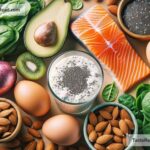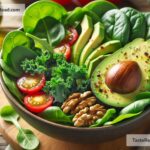Foods That Improve Heart Rhythm: How to Keep Your Heart Healthy
Your heart is one of the most important organs in your body. It beats tirelessly, pumping blood to deliver oxygen and nutrients to every part of you. A healthy, steady heart rhythm is essential for maintaining good health, but sometimes factors like stress, lifestyle choices, or health conditions can disrupt its natural rhythm, leading to issues such as irregular heartbeat (arrhythmia). The good news is that the food you eat can play a big role in supporting heart health and improving your heart rhythm. In this blog, we’ll explore simple, healthy foods that can help your heart stay strong and beat smoothly.
1. Oily Fish: Rich in Omega-3 Fatty Acids
Oily fish like salmon, mackerel, and sardines are packed with omega-3 fatty acids, which are excellent for heart health. These essential nutrients have anti-inflammatory properties and help regulate heartbeat by promoting better electrical signaling in the heart. Omega-3s can also reduce the risk of arrhythmias and lower triglycerides, a type of fat in the blood that can harm heart health.
If you don’t like fish, you can still get omega-3s from plant-based sources like chia seeds and flaxseeds. Fish oil supplements are also an option, but consult your doctor before taking them.
2. Leafy Greens: A Source of Magnesium
Magnesium is a mineral that plays a major role in heart function and helps maintain a steady heartbeat. Leafy greens like spinach, kale, and Swiss chard are rich in magnesium. This mineral helps relax the blood vessels, improves circulation, and supports the delicate electrical activity that governs your heart rhythm.
Adding leafy greens to your diet doesn’t require a gourmet recipe. You can toss spinach into a salad or blend kale into a green smoothie. Simple foods can make a big impact on your heart health.
3. Avocados: Heart-Healthy Fats
Avocados are a delicious way to support your heart rhythm. They are rich in potassium, a mineral that balances the electrical activity of the heart and helps normalize irregular heartbeats. Potassium also plays a crucial role in maintaining healthy blood pressure levels, which is essential for heart health.
Avocados’ healthy monounsaturated fats can also help lower bad cholesterol, further protecting your heart. Top your toast, make guacamole, or add avocado slices to your sandwiches—no matter how you eat them, your heart will thank you!
4. Nuts: Tiny Powerhouses for Your Heart
Nuts like almonds, walnuts, and pistachios are packed with heart-friendly nutrients such as magnesium, potassium, and healthy fats. These nutrients strengthen the heart’s electrical system and help prevent arrhythmias. Walnuts, in particular, are rich in omega-3 fatty acids, similar to those found in oily fish.
Grab a handful of nuts as a snack or sprinkle them on your oatmeal or salad. Just remember to choose unsalted varieties to avoid consuming too much sodium, which can strain your heart.
5. Bananas: Potassium-Rich and Heart-Friendly
Bananas are one of the best natural sources of potassium. This mineral is essential for balancing electrolytes in the body and ensuring your heart keeps beating steadily. Potassium helps prevent high blood pressure, which can lead to heart rhythm problems.
Bananas are a convenient snack you can take anywhere, and they pair well with other heart-healthy foods like almond butter or oatmeal.
6. Whole Grains: Boosting Circulation
Whole grains like brown rice, quinoa, oats, and whole wheat bread are filled with fiber, vitamins, and minerals that promote heart health. They also help regulate cholesterol and improve blood circulation, ensuring your heart gets the oxygen and nutrients it needs to function properly.
Switching to whole-grain options in place of refined carbohydrates, like white bread or sugary cereals, is a smart move for improving heart rhythm and overall health.
7. Dark Chocolate: A Sweet Treat for Your Heart
Yes, you read that right! Dark chocolate (with at least 70% cocoa) can be good for your heart when eaten in moderation. It contains antioxidants called flavonoids, which help reduce inflammation and improve blood flow. A healthy heart rhythm relies on good blood circulation, and dark chocolate is a tasty way to support it.
But remember, portion matters. Stick to one or two small squares to avoid consuming too much sugar or saturated fat.
8. Berries: Nature’s Superfood for Your Heart
Berries like blueberries, strawberries, and raspberries are rich in antioxidants and vitamins. These tiny fruits help fight inflammation and reduce oxidative stress, both of which can disrupt heart rhythm. They also contain fiber to improve cholesterol levels and keep your heart functioning at its best.
Enjoy berries in smoothies, on top of yogurt, or as a refreshing snack during the day.
9. Herbs and Spices: Flavor Meets Health
Certain herbs and spices can improve heart health while adding flavor to your meals. For instance, garlic contains compounds that can lower blood pressure and improve circulation. Turmeric, with its active ingredient curcumin, has anti-inflammatory effects that benefit your heart. Cinnamon may help regulate blood sugar, reducing stress on your heart.
Adding these spices to your cooking is a simple way to enhance heart rhythm and overall health.
Final Thoughts
Your heart plays a central role in your health, so keeping it strong and steady should be a top priority. While medications and interventions may be necessary for some heart conditions, incorporating heart-friendly foods into your diet is a natural and effective way to support your heart rhythm. Whether it’s omega-3-rich fish, potassium-packed bananas, or fiber-filled whole grains, the choices you make at mealtime can make a big difference to your heart.
Small changes can lead to big improvements. Start including these foods in your daily diet, and your heart will thank you in the long run! Stay healthy, and let your heart beat happily.


